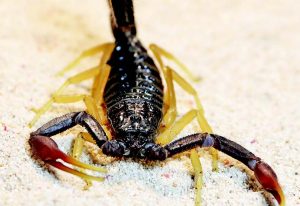Humans have always been fascinated by the creatures they share the world with, and those that are potentially lethal to their existence are no exception. For instance, venomous scorpions remain rather captivating among enthusiasts, in both its appearance and its potential to cause severe pain, if not death.
A scorpion with potent venom, the Hottentotta franzwerneri was dubbed by A.A. Birula in 1914 as Buthus franzwerneri, derived from a male specimen collected by Franz Werner on Béni Ounif de Figuig in Algeria, bordering on Morocco. Birula also came up with the name Hottentotta in 1908, but originally as a subgenus under Mesobuthus. The species is confined to Algeria and Morocco.
Despite having been known to science even from the early 1900s, H. franzwerneri remained one of the most poorly known of scorpion species. But captive-bred individuals are changing that, and the world of arachnoculture is now bestowed with perhaps one of the most arresting species ever made available.
Appearance
Hottentotta franzwerneri is a medium-sized species that grows to a total length of 11 centimeters. The reticulated chelicerae range from yellow to black, while the carapace is also black with red-brown chela on the pedipalps and telson. The chelae have no carinae (keels).
The legs are a contrasting yellow; black-legged populations have been previously assigned to subspecies gentili, which is now regarded as a true species.
The carapace of H. franzwerneri is distinctly rugose, which is so developed that the keels on the head have also been broken down to minute bumps; this character is shared apparently only by H. judaicus, and to some extent, H. geffardi. The entire body is noticeably hirsute, although the males have been noted to be less so than females. Sexing the scorpions is easy- males have pectines close to one another, while there is a very noticeable gap for females.
Habitat
Béni Ounif in Algeria is situated at an elevation of 2,720 meters above sea level, characterized by rocky outcrops from the north but flatter elsewhere. In Figuig on Morocco, which forms a border to Algeria, these scorpions were found at an altitude of 868 meters.
The riverside habitats as well as oases support vegetation, dominated by date palms (Phoenix dactylifera), which provide an important agricultural crop to local inhabitants. Within the leaf axils of these palms, H. franzwerneri lives, which affords them more stable conditions.
However, the species can also be found on stony outcrops on the ground, wedged in between gaps, to escape the stratospheric heat and to secure potential prey. These scorpions are not known to dig burrows. Due to the proximity of bodies of water, ambient humidity is higher than in the surrounding, more arid habitats. Annual rainfall is very low, and the area is notably hot in the summers but cool during winter.
In Captivity
Hottentotta franzwerneri (the species name is pronounced ‘franz-vferneri’) is a welcome change from the ubiquitous H. hottentotta, and is very easy to maintain in captivity, but slow-growing. These are not a truly arid species, and prolonged dryness can have irreversible negative effects on these scorpions. However, very humid conditions can promote an outbreak and will also prove fatal to the inhabitants.
Substrate can be equal parts river sand and sifted coco peat, with some flat rocks for decoration where the animals can also squeeze through. Rocks, however, need to be anchored firmly, as a collapsed structure can easily squash a scorpion. Alternatively, pieces of bark can be laid on the substrate and these provide a safer course of action, although aesthetically less pleasing.
In the wild, H. franzwerneri obtains its liquid requirements mostly from its prey items, but will drink droplets of water if the opportunity arises. Water receptacles are not often used, unless the specimens are close to dehydration, but such containers assist in humidifying an otherwise dry setup.
An individual can be kept in a 2.5 gallon tank, but a small group is better accommodated on a tank with a 5 gallon capacity. It cannot be stressed enough that a highly secure lid is imperative, particularly for genera known to include species with medically significant venom.
Few scorpion species can be kept communally, and this is particularly true for the more potent members of the Buthidae family. However, H. franzwerneri has been maintained in group set-ups, with intra-species aggression appearing to be more pronounced on juveniles rather than on adults; like in many scorpion species, the risks of cannibalism is greatest when the individuals are still instars.
These scorpions breed straightforwardly and easily, but one preferably has to have a breeding group to allow the scorpions to choose their own mates. Brooding females do not seem to be aggressive toward tank mates of both sexes, unless the terrarium is too crowded.
This appeared in Animal Scene magazine’s August 2018 issue.







